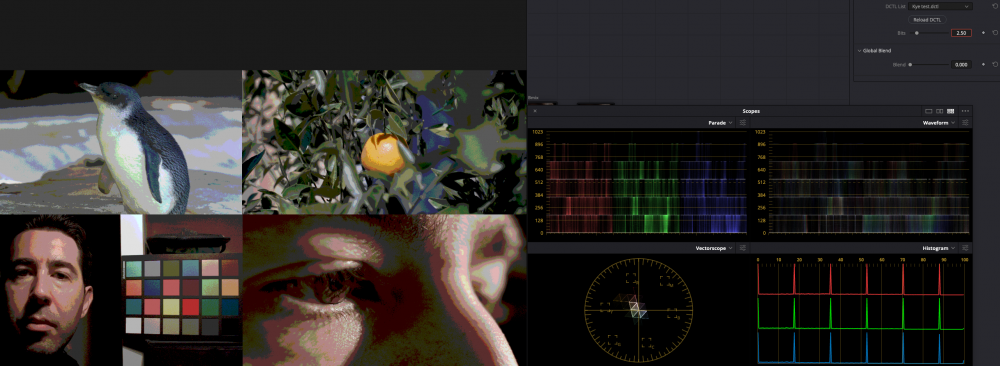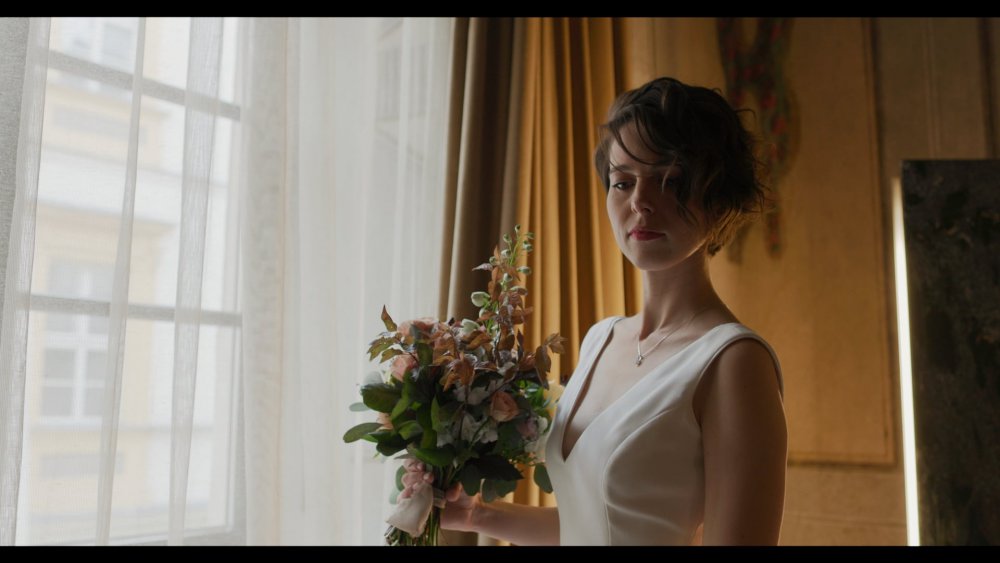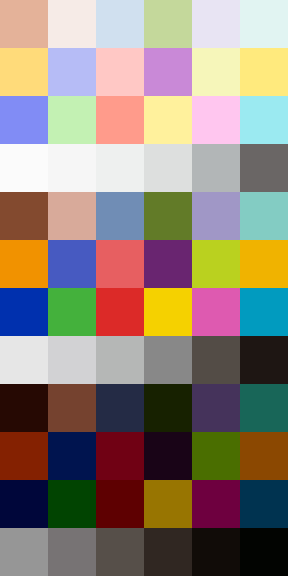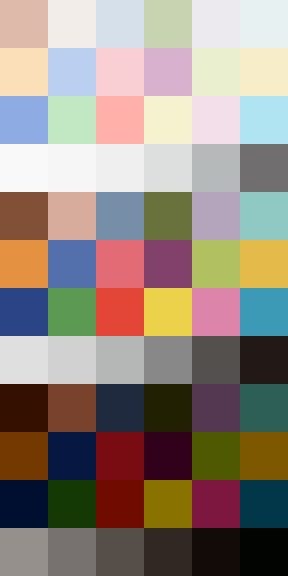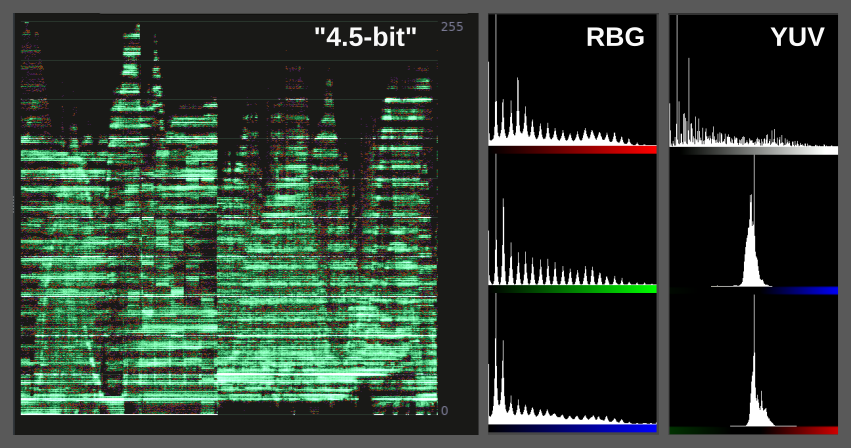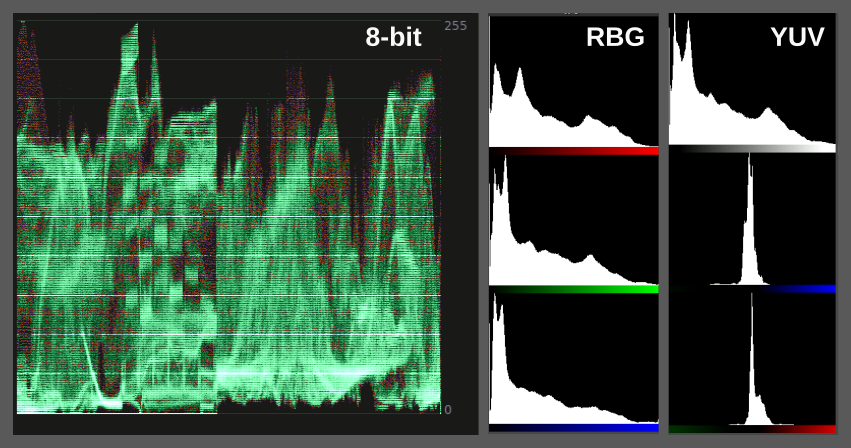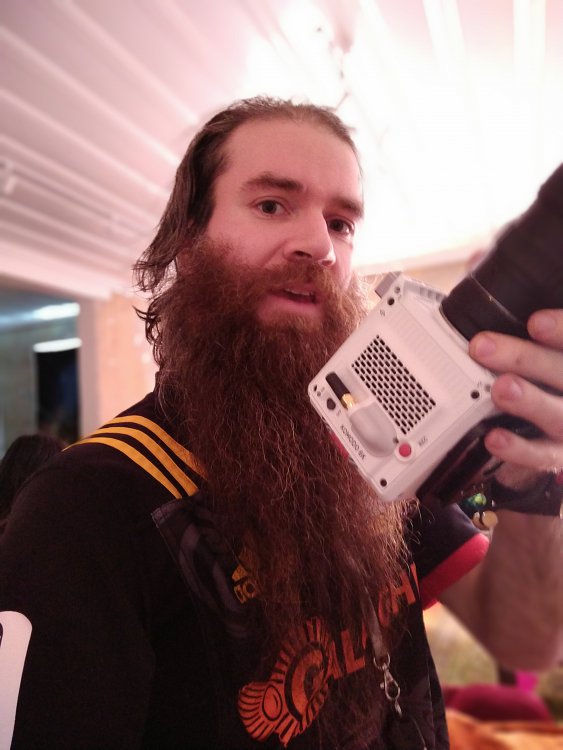Leaderboard
Popular Content
Showing content with the highest reputation on 10/13/2020 in all areas
-

iPhone 12 Pro Max - "ProRAW" and 5 axis IBIS
Juank and 2 others reacted to Andrew - EOSHD for a topic
Pretty amazing https://www.eoshd.com/news/iphone-12-pro-max-marches-into-enthusiast-and-pro-photography-territory-with-new-apple-proraw-lidar-dolby-vision-and-large-sensor/3 points -
BRAW does not work that way, it has to be calibrated to each camera.2 points
-
It might be, that's interesting. I'm still working on the logic of subtractive vs additive colour and I'm not quite there enough to replicate it in post. Agreed. In my bit-depth reductions I added grain to introduce noise to get the effects of dithering: "Dither is an intentionally applied form of noise used to randomize quantization error, preventing large-scale patterns such as color banding in images. Dither is routinely used in processing of both digital audio and video data, and is often one of the last stages of mastering audio to a CD." Thickness of an image might have something to do with film grain, but that's not what I was testing (or trying to test anyway). Agreed. That's why I haven't been talking about resolution or sharpness, although maybe I should be talking about reducing resolution and sharpness as maybe that will help with thickness? Obviously it's possible that I made a mistake, but I don't think so. Here's the code: Pretty straight-forwards. Also, if I set it to 2.5bits, then this is what I get: which looks pretty much what you'd expect. I suspect the vertical lines in the parade are just an algorithmic artefact of quantised data. If I set it to 1 bit then the image looks like it's not providing any values between the standard ones you'd expect (black, red, green, blue, yellow, cyan, magenta, white). Happy to hear if you spot a bug. Also, maybe the image gets given new values when it's compressed? Actually, that sounds like it's quite possible.. hmm. I wasn't suggesting that a 4.5bit image pipeline would give that exact result, more that we could destroy bit-depth pretty severely and the image didn't fall apart, thus it's unlikely that thickness comes from the bit-depth. Indeed there is. and I'd expect there to be! I mean, I bought a GH5 based partly on the internal 10-bit! I'm not regretting my decision, but I'm thinking that it's less important than I used to think it was, especially without using a log profile like I also used to do. Essentially the test was to go way too far (4.5bits is ridiculous) and see if that had a disastrous effect, which it didn't seem to do. If we start with the assumption that cheap cameras create images that are thin because of their 8-bit codecs, then by that logic a 5-bit image should be razor thin and completely objectionable, but it wasn't, so it's unlikely that the 8-bit property is the one robbing the cheap cameras of their images thickness.2 points
-

The Panasonic DC-BGH1 camera soon to be announced
John Matthews reacted to Emanuel for a topic
What good news! Really excited about : ) Best Panny AF performance ever to my eyes... WOW Need to check not under direct/key light now :- ) Wondering how AF will match or not under low light...1 point -
AF seem quite bit better than S5/GH5S for sure!1 point
-
ProRes Raw and Davinci Resolve
Mark Romero 2 reacted to ntblowz for a topic
Atm Apple definitely have the upper hand on camera supporting their RAW format. People will have to choose FCX or Premiere with ProresRaw support or Da Vinci for BRAW and the RAW their camera support, or Red camera which red raw is supported by all NLE. It's definitely not buy camera and expect to work with your NLE, or ur NLE will support all the feature from your new camera, have to pick a side! Hence I m still on Premiere lol, can work with all cameras1 point -

ProRes Raw and Davinci Resolve
Mark Romero 2 reacted to Geoff CB for a topic
No, none of these compressed RAW formats are actually RAW, they are compressed raw formats that toss out data. They all need to be designed on a camera by camera basis.1 point -
The URSA Mini Pro 12K
TheRenaissanceMan reacted to majoraxis for a topic
This youtube video lists the camera as "Ursa Mini Pro 12k". Wow - impressive! The color rendition is special in the way that the different shades of a color appear distinct and unique even when they are very similar. I also like the motion cadence. The image is solid and without distraction. It's nice to not have any obvious flaws that steel my attention from the content.1 point -
When grading files in HDR, I can instantly tell when a file is of lower quality. Grading on a 8-bit timeline doesn't really show the difference, but on a 10 or 12-bit HDR timeline on a HDR panel it is night and day. So for me for a "Thick" image. is 10-bit 4:2:2 or better with at least 14+ Stops of DR.1 point
-
I always think of it as related to compression TBH, AKA how much you can push colour around and have things still look good. C100 with external recorder for example looked way better than internal, cos the colours didn't go all "thin" and insipid if you pushed it about, Trying to white balance adjustments on over-compressed footage results in a sort of messy colour wash. I think of this as "thin", the opposite as "thick"1 point
-

ProRes Raw and Davinci Resolve
Mark Romero 2 reacted to jgharding for a topic
If the S1H would just output Braw i'd go and buy a blackmagic recorder... Format wars are so tedious1 point -

The Panasonic DC-BGH1 camera soon to be announced
Amazeballs reacted to Tim Sewell for a topic
This could have been interesting but: 1. Too expensive. It's around the same price as the GH5S, yet has no screen, no evf, no battery and - presumably - no strap or charger. So WTF, Panasonic - should be cheaper, if anything? 2. The reason we always get for the lack of internal NDs in hybrid cameras is a lack of space. No NDs in this - why?1 point -

Sony A7S III
Rinad Amir reacted to ajay for a topic
The "gyro magic" is nice but it requires added steps, crops in quite a bit and makes my face fatter🤔. I might use it occasionally.1 point -

Image thickness / density - help me figure out what it is
tupp reacted to hyalinejim for a topic
1 point -

Image thickness / density - help me figure out what it is
tupp reacted to hyalinejim for a topic
This harks back to deezid's point: From my investigations film does seem to have much more saturated shadows than what a digital image offers. If you match the saturation of the midtones of digital to film, then the shadows will need a boost to also match... maybe by around 25-50% at the lowest parts. It's a shockingly huge saturation boost in the shadow areas (and the highlights would need to come down in saturation slightly). I'm not talking about log images here, I'm talking contrasty Rec709. The digital capture is probably closer to being an accurate representation of the level of saturation in reality. But film is transformative. We want our images to look better than reality! If we talk about memory colours (sky, foliage and skin) the preferences of photographers and middle American shoppers led to altered hue and saturation in Kodak film stocks. So it looks like we prefer skies that are more cyan than in reality, foliage that is cooler and skin that is more uniform, and tending towards tan (Fuji skin tends towards rosy pink). With 10bit I can get decent, filmic colour out of V-Log! But 8 bit would fall apart.1 point -
Sorry for the delay. The rig. Metabones BMMCC version, Shinobi, small rig wood grip, RADIOPROK HDMI , expansion box and button, small rig top grip and sony battery. I want to covert a couple of my FD lens to EF so I can use them at a better crop. The picture between my P4K and Micro work so well together. Some slight tweaks are needed but nothing hard. I personally like the Micro for closer shooting and the 4K for landscapes and distance shots. Sorry for the out of focus but here it is. Screen grab from the Micro on a native cutthroat from CO. -Dave1 point
-
It is a bit like people calling you Italian... How is life in Turkey going for you? 😉 Many people would think paying a few extra hundred dollars for Panasonic's brand name and track record is worth it over getting a Z Cam / BMD. Even has Genlock! That's surprising, especially at this price point (the cheapest ever? Perhaps). But it kinda makes for their target audience of semi pro streamers.1 point
-
1 point
-
I think that the "thickness" comes primarily from emulsion's color depth and partially from the highlight compression that you mentioned in another thread, from the forgiving latitude of negative film and from film's texture (grain). Keep in mind that overlaying "grain" screen on a digital image is not the same as the grain that is integral to forming an image on film emulsion. Grain actually provides the detail and contrast and much of the color depth of an film image. Home movies shot on Super8 film often have "thick" looking images, if they haven't faded. You didn't create a 5-bit image nor a "4.5-bit" image, nor did you keep all of the shades within 22.6 shade increments ("4.5-bits") of the 255 increments in the final 8-bit image. Here are scopes of both the "4.5-bit" image and the 8-bit image: If you had actually mapped the 22.6 tones-per-channel from a "4.5-bit" image into 26.5 of the 255 tones-per-channel 8-bit image, then all of the image's pixels would appear inside 22 vertical lines on the RGB histograms, (with 223 of the histogram lines showing zero pixels). So, even though the histogram of the "4.5-bit" image shows spikes (compared to that of the 8-bit image), the vast majority of the "4.5-bit" image's pixels fall in between the 22.6 tones that would be inherent in an actual "4.5-bit" image. To do this comparison properly, one should probably shoot an actual "4.5-bit" image, process it in a "4.5-bit" pipeline and display it on a "4.5-bit" monitor. By the way, there is an perceptible difference between the 8-bit image and the "4.5-bit" image.1 point
-
Everytime I read about the "full frame" look, I literally turn green! It is a blasthemy to just ignore that 99% of the total planet output, maybe more, was shot on a smaller format for so many decades, and noone ever complained. It is the new trend, I get it, but do not pretend it is a problem or there are not options/solutions. In run n gun/verite style we usually use Canon C and FS cameras, and I know shows using even smaller sensored cameras (even main news channels, DW, Reuters and the such, I have seen them using camcorder styled cameras). We get it, some are so young that 5DmkII is all they knew, but don't try to oversell it, it is just a hybris to our trade. Surprisingly the C70 is heavier than the C100mkII. This is a dense camera!1 point
-

Poor Olympus E M1 Mark III video specs
John Matthews reacted to rdouthit for a topic
Since posting that, I also bought an EM1X. The pair make a great multi-angle setup when filming off-road tests (in all sorts of weather) for YouTube.1 point -
Panasonic S5 Entry Level Full Frame seems to be real...
Lux Shots reacted to herein2020 for a topic
I completely loathe my Ronin-S as well, in fact, I posted so much on the DJI forum about its complete failure to return to center that I got banned there; no other gimbal on the planet has this problem and DJI completely refuses to acknowledge or fix it; in fact no other gimbal that DJI makes including their drones, the Ronin M/MX, Ronin etc does this......but that's a different rant for a different day. It is without a doubt the most annoying piece of gear that I own. I don't like the Crane either; the shape with the permanent low slung handle just doesn't appeal to me; the gimbal that I really want to try is the Lotus Helix but almost no one talks about it. There is a guy in LA that shoots amazing dance videos and he uses it, but that's the only one I could find. So I'm stuck with the Ronin S, I've fiddled with the settings and calibration endlessly and now I have 3 modes programmed in that work for me (real estate, general purpose, and music video). As far as locking up the camera, personally I would never attach any of these gimbals to the camera. I feel like DJI and the rest of them came up with a hack to get the AF to work in ways that is not supported by the vendor. I'm perfectly fine with MF on the gimbal; sure its more work, and sure you will have to throw away some footage, but its better than frying your camera or having the AF drift off to the background somewhere during a critical moment. This past year, my gimbal use really declined, I shoot more and more footage with just a monopod or handheld.1 point -
The question we're trying to work out here is what aspects of an image make up this subjective thing referred to by some as 'thickness'. We know that high-end cinema cameras typically have really thick looking images, and that cheap cameras typically do not (although there are exceptions). Therefore this quality of thickness is related to something that differs between these two scenarios. Images from cheap cameras typically have a range of attributes in common, such as 8-bit, 420, highly compressed, cheaper lenses, less attention paid to lighting, and a range of other things. However, despite all these limitations, the images from these cameras are very good in some senses. A 4K file from a smartphone has a heap of resolution, reasonable colour science, etc, so it's not like we're comparing cinema cameras with a potato. This means that the concept of image thickness much be fragile. Otherwise consumer cameras would capture it just fine. If something is fragile, and is only just on the edges of being captured, then if we take a thick image and degrade it in the right ways, then the thickness should evaporate with the slightest degradation. The fact I can take an image and output it at 8-bits and at 5-bits and for there not to be a night-and-day difference then I must assume one of three things: the image wasn't thick to begin with it is thick at both 8-bits and 5-bits and therefore bit-depth doesn't matter than much it is thick at 8-bit but not at 5-bits and people just didn't notice, in a thread especially about this I very much doubt that it's #3, because I've had PMs from folks who I trust saying it didn't look much different. Maybe it's #1, but I also doubt that, because we're routinely judging the thickness of images via stills from YT or Vimeo, which are likely to be 8-bit, 420, and highly compressed. The images of the guy in the car that look great are 8-bit. I don't know where they came from, but if they're screen grabs from a streaming service then they'll be pretty poor quality too. Yet they still look great. I'm starting to think that maybe image thickness is related to the distribution of tones within a HSL cube, and some areas being nicer than others, or there being synergies between various areas and not others.1 point
-
Canon Cinema EOS C70 - Ah that explains it then!
Xavier Plagaro Mussard reacted to currensheldon for a topic
With all that being said, a speedbooster takes care of the issue on the C70, because now you can use EF full-frame lenses, either the 24-105mm lenses that have great IS and still get you f2.8 or snag a 24-70mm and have an f2. Pretty great.1 point -
Can you help me understand your experience a bit when you say "awkward focal lengths on Super35"? Like, under what conditions are you shooting? The filmmakers I studied under using Super 35, its equivalent sensor size, or a 4/3rds sensor always used focal lengths that were readily compatible with common "full frame" lenses. For doc interviews, I was taught 50mm/35mm (Super 35 and 4/3rds, respectively) for A Cam, 35mm/24mm for B Cam with wider-than ~50º field of view kind-of a niche thing because of perspective distortion. Because of that experience, I've always been happy shooting APS-C with 16-35mm, 24-70mm, and 70-200/300mm L zooms in my bag (I also have a 10-18mm STM but I never use it for doc work).1 point
-
The Panasonic DC-BGH1 camera soon to be announced
IronFilm reacted to UncleBobsPhotography for a topic
I wouldnt disapprove of IBIS either, but for a camera that can be powered and controlled over ethernet, it doesn't exactly target the same users that needs IBIS.1 point -
There’s the excellent RF 15-35, not a lot of reach but will be great for indoors. Though in that use case I’d prefer the Sigma 18-35 and just use digital IS, if it’s as good on the C70 as it is on my R. I personally like the 18-135 image, and for outdoor ENG, especially when paired with a body (like the C70) that supports corrective auto iris. There’s the option to add servo ‘power zoom‘ with the nano version, but I never did. For a one and done though, I’d still be rocking that trusty 17-55 and cropping out any really obvious vignetting in post, when needed. My C100 would crop in for EF-S lenses so hoping the C70 has a similar setting, maybe combined with some fancy RF-era improvement for peripheral illumination correction. For me the only thing against 17-55 is its autofocus - old fashioned and certainly not the smoothest - yeah it’s definitely been crying out for an upgrade for years! Still, it’s a solid doc lens, I’d never sell mine. Not until we see some RF-S type glass but I won’t hold my breath. C70 ticks a lot of my boxes on paper (except EVF... hmmm) so looking forward to scrutinising footage of its DR etc and keen for some real world reports - especially on the ergonomics.. Not sure how it would feel, how I’d hold it (or brace it, especially without EVF) or how well my usual rig would work with it. Sounds like nitpicking but I’d definitely want to rent one before investing.1 point
-

Image thickness / density - help me figure out what it is
Ricardo Constantino reacted to kye for a topic
That's what I thought - that there wasn't much visible difference between them and so no-one commented. What's interesting is that I crunched some of those images absolutely brutally. The source images were (clockwise starting top left) 5K 10-bit 420 HLG, 4K 10-bit 422 Cine-D, and 2x RAW 1080p images, which were then graded, put onto a 1080p timeline and then degraded as below: First image had film grain applied then JPG export Second had film grain then RGB values rounded to 5.5bit depth Third had film grain then RGB values rounded to 5.0bit depth Fourth had film grain then RGB values rounded to 4.5bit depth The giveaway is the shadow near the eye on the bottom-right image which at 4.5bits is visibly banding. What this means is that we're judging image thickness via an image pipeline that isn't that visibly degraded by having the output at 5 bits-per-pixel. The banding is much more obvious without the film grain I applied, and for the sake of the experiment I tried to push it as far as I could. Think about that for a second - almost no visible difference making an image 5bits-per-pixel at a data rate of around 200Mbps (each frame is over 1Mb).1 point -
Nope, a Kiwi! (New Zealander, in Auckland, spent most of my life here)1 point
-

The top 20 most popular cameras of all time on the EOSHD Forum
solovetski reacted to IronFilm for a topic
1 point -
The GX85 thread helped me decide to try a 4K camera with IBIS. That lead me to leaving Canon (C100 and 700D) for a GH5, GH5S and GX85 (Hong Kong no recording limit). On the whole I have been happy as although I loved the C100, the Panasonics are a lot lighter and I can carry a 3 camera kit in a back pack. So that was my favourite thread.1 point
-
Panasonic EVA-2 Wish List
currensheldon reacted to Video Hummus for a topic
*turns dial to C1 for 6K60p1 point

